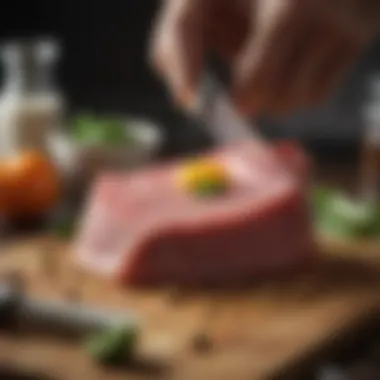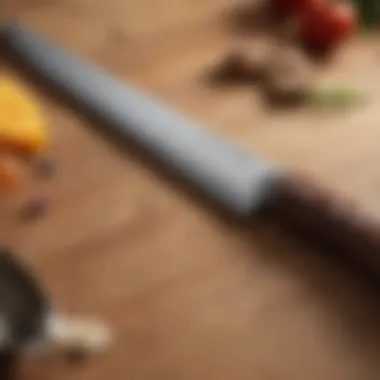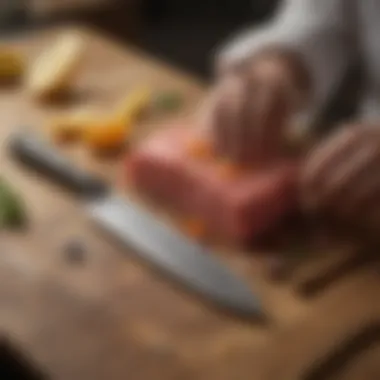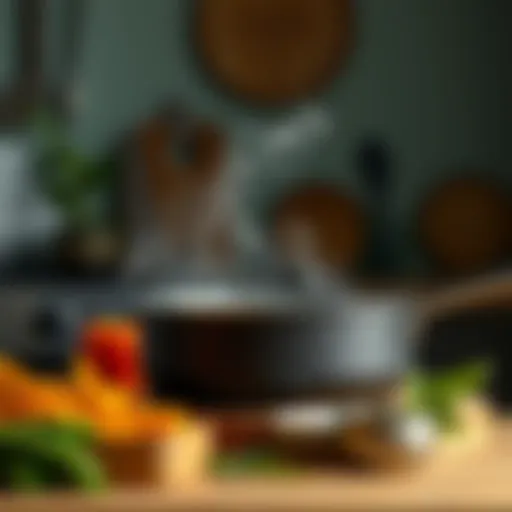Understanding the Importance of Chef Knife Size


Intro
The world of culinary arts is vast, filled with tools and techniques that shape the way we prepare food. Among these tools, the chef knife occupies a pivotal role. A chef knife is not just an ordinary blade; it’s often referred to as a kitchen's workhorse. Its size significantly impacts not only the comfort and ease of use for the cook but also the final presentation and flavor of the dishes served.
Understanding the different sizes of chef knives can seem as intricate as a chef's special recipe. It can be tempting to pick up any knife that looks fancy or falls within a reasonable price range, but choosing the right one demands a bit more thought. The size of a chef knife influences how a chef handles ingredients, cuts through different textures, and navigates complex recipes. In this exploration, we’ll delve into the nuances of chef knife sizes, revealing how they contribute to precision, control, and overall effectiveness in the kitchen.
As we proceed, we’ll explore various aspects that highlight not only the technical features but also the personal preferences that play a role in selecting the right knife. It’s vital to appreciate that choosing a chef knife is not merely about aesthetic appeal; it's about enhancing one's culinary experience and mastering the art of cooking. Let's embark on this insightful journey into the realm of chef knife sizes.
Preamble to Chef Knives
Chef knives are often regarded as the backbone of any kitchen. The importance of understanding these knives cannot be overstated. They are versatile tools that can help cooks of all experience levels slice, chop, and dice in a matter of moments. And among the various aspects to consider, knife size plays a pivotal role in how effectively these tasks are executed.
A well-sized knife can provide the control and precision needed for intricate tasks, while a poorly sized one might lead to frustration or accidents. It's crucial to choose a knife that not only fits the specific task at hand but also aligns with the user's personal comfort and skill level. The right knife size can enhance efficiency during meal prep, reduce strain on the wrist and hand, and even elevate the overall cooking experience.
In this exploration, we’ll delve into different knife sizes, their historical context, and other elements that contribute to choosing the right one for your culinary needs. Expect a deep dive that will resonate with seasoned chefs and cooking enthusiasts alike, aiding in making informed choices in the kitchen.
Understanding the Chef Knife
At its core, the chef knife is more than just a cutting tool; it symbolizes culinary craftsmanship. Typically ranging from 6 to 12 inches in blade length, it is designed for various chopping, slicing, and dicing tasks. Generally, the blade features a slight curve from the heel to the tip, allowing the user to rock the knife back and forth for efficient slicing. The balance of the knife is crucial; a well-balanced knife can make all the difference between a comfortable experience and a strained one.
Blade Material also plays a role in the knife's functionality. High-carbon stainless steel, for example, tends to maintain its sharpness longer, while ceramic blades are lightweight and resistant to corrosion. Yet, they often lack the heft and versatility required for heavier tasks.
In a nutshell, the chef knife is an indispensable tool, combining practicality and artistry. Its design caters to a variety of tasks, making it essential for anyone aspiring to refine their culinary skills.
Historical Context of Chef Knives
The origins of the chef knife can be traced back to various cultures, evolving over centuries to reach its current form. Historically, knives were primarily crafted for functionality, with the chefs of medieval times wielding rudimentary versions to prepare meals. As culinary practices advanced, so did the knife’s design, influenced by different cooking techniques and food preparation styles.
In France, the modern chef knife as we know it began taking shape in the late 19th century. It was a response to the growing need for a multi-functional tool that could handle a variety of kitchen tasks. The term "chef knife" is derived from the word "chef de cuisine," highlighting its importance to chefs in professional kitchens.
Over the years, various cultures have contributed to the development of chef knives, each bringing unique elements and enhancing their utility. Whether it be the Japanese gyuto, with its distinct shape and lightweight feel, or the German gyuto, which tends to be heavier and sturdier, the cultural influence is palpable in the knives used around the world.
"Understanding the historical context of chef knives gives one a deeper appreciation for their design and use in modern cooking."
In essence, the evolution of the chef knife mirrors the growth of culinary arts, marking the transition from utilitarian tools to symbols of skilled craftsmanship. As cooks continue to refine their skills, the right knife plays an indispensable role in their culinary journey.
Defining Knife Sizes
Understanding knife sizes is fundamental in grasping the larger theme of culinary arts. Having the right knife size can make or break a chef's experience in the kitchen. Each size serves its own niche, and knowing what to select can lead to improved functionality and increased enjoyment when preparing meals. Proper definition of sizes not only refers to measurements but also encompasses ergonomics, balance, and the kind of tasks a cook might be facing. It’s a holistic approach to taking control of your culinary endeavors.
Common Sizes of Chef Knives
When diving into the world of chef knives, it's essential to familiarize oneself with the distinct sizes available. Each choice offers different benefits depending on the nature of the culinary pursuits. Let's explore the three primary sizes: small, medium, and large chef knives.
Small Chef Knives
Small chef knives typically range from 6 to 8 inches in blade length. These knives shine in precision tasks, such as slicing herbs, peeling vegetables, or fine chopping. The compact design allows for nimble maneuvering, which is crucial during intricate food preparations.
A key characteristic of small chef knives is their lightweight nature. This makes them a favorite among those who prefer to maintain finesse over brute force. They are perfect for cooks who often handle delicate ingredients or require tight cutting control.
One unique feature worth noting is their ability to easily navigate around curves, making them ideal for decorative work. However, the limitation comes when faced with bulk tasks, where larger alternatives might prove more effective.
Medium Chef Knives
Medium chef knives stretch from 8 to 10 inches. They strike a balance between versatility and ease of control, making this size popular among both novice and experienced cooks alike. Their ability to perform a broad range of tasks—from dicing onions to cutting roasts—makes them essential in any kitchen.
A fundamental aspect of medium chef knives is their adaptability. They allow for a range of techniques, whether you’re chopping, mincing, or slicing thinly. This adaptability caters well to those who enjoy a variety of cooking styles.
The unique feature here is their powerful leverage during cutting. While they can perform intricate tasks like smaller knives, their size also allows for handling larger cuts of meat or vegetables efficiently. However, this versatility may lead to a compromise on precision in some intricate tasks compared to their smaller counterparts.
Large Chef Knives
Large chef knives generally exceed 10 inches in blade length. Their design caters specifically to heavy-duty tasks such as chopping through bones or slicing large cuts of meat. This size is especially beneficial for kitchen environments that see a lot of batch cooking or preparation for large gatherings.
The key characteristic of large chef knives is their sheer weight and blade length, which equates to increased cutting power. This is invaluable when handling a lot of bulk ingredients, where speed and efficiency become paramount.
However, with such size comes a unique feature: possible awkwardness for smaller hands or those less experienced in handling larger blades. While they excel in heavy tasks, their unwieldy nature can hinder precision when finer cuts are necessary.


Measuring Knife Size
Understanding how to measure knife size is just as crucial as knowing the sizes themselves. This ensures that one can select the most appropriate tool for the job.
Blade Length
The blade’s length is the most obvious measurement when defining a chef knife’s size. It's a determining factor for how the knife will interact with food preparation tasks. The blade length directly impacts control and force, with shorter blades offering agility and longer blades providing reach and power.
A major consideration is that longer blades excel at large cuts but can hinder detail work where shorter blades shine. This sometimes leads to frustration, especially when precision is needed.
Unique to blade length is the cutting pattern it encourages; longer blades often favor a rocking motion, while shorter ones lend themselves to steady up-and-down cutting motions. The ideal length heavily depends on individual cooking styles, suggesting that the length of one's knife should be based on personal preferences and the specific tasks they commonly undertake.
Width and Thickness
The knife's width and thickness also play significant roles in defining its function. A wider blade can help in transferring chopped ingredients straight to a pot or pan, which proves handy in a busy kitchen. Meanwhile, added thickness contributes to durability and stability when cutting through tough materials.
One aspect of width and thickness to consider is how these measurements affect the overall heft of the knife. A thicker blade, for example, might be perceived as more robust, leading some users to prefer it for heavy-duty tasks. However, a thinner blade can offer better precision, especially in delicate jobs.
Size Matters: Functions of Different Knife Sizes
Understanding the role that knife size plays in cooking can significantly enhance your culinary skills. Knife size isn’t merely a preference; it directly influences precision, control, and the kind of techniques a cook can apply. This section delves deep into how different chef knife sizes function and what benefits each size brings to the kitchen.
Usage of Small Chef Knives
Precision Tasks
Small chef knives shine when it comes to precision tasks. Their compact size allows for detailed control, making them ideal for tasks that require accuracy, such as trimming fat from meat or cutting delicate herbs. The most crucial characteristic of these knives is their agility; they can maneuver in tight spaces unlike their larger counterparts.
Small knives can be a beneficial choice for those who often work with intricate food presentations or garnishes. One unique feature that stands out is their ability to facilitate tasks where finesse trumps brute force. However, they may not be as efficient for heavy chopping tasks, which highlights a potential disadvantage in busy kitchen environments.
Peeling and Paring
Peeling and paring with small knives is another area where these tools excel. The slim blade design makes them perfect for stripping away skins from fruits and vegetables, allowing for a clean and controlled approach. Their key characteristic lies in their ease of handling, which provides an almost customized feel for the user.
This specialization is what makes them an essential part of any culinary toolkit. The downside, perhaps, is that they may lack the weight needed for more rigorous slicing tasks, which can limit their versatility in some cooking scenarios.
Medium Chef Knives: A Versatile Choice
General Chopping
Medium chef knives serve as the Swiss army knife of the kitchen, capable of performing various cutting tasks with ease. Their size strikes a balance between control and power, making them a popular choice for general chopping. You can swiftly chop vegetables for a stir-fry or cut proteins without feeling out of control.
This versatility is their standout feature. Medium knives are beneficial for cooks who need a one-stop tool for several functions. However, their middle-ground size can sometimes mean they lack the heft for very dense ingredients.
Detailed Slicing
For those culinary tasks demanding detailed slicing, medium chef knives are often the go-to choice again. Their blade length allows for long, even cuts, which are essential for creating uniform pieces of food. This facilitates both aesthetics and cooking consistency.
The essential characteristic here is the balance of blade length and handle comfort. It makes it easier to execute precise cuts while ensuring the user maintains control over their movements. However, one must be careful with the technique; improper use can lead to uneven slices, impacting the dish’s final presentation.
Benefits of Large Chef Knives
Heavy-Duty Tasks
Large chef knives are indispensable when it comes to heavy-duty tasks in the kitchen. Tasks like breaking down large cuts of meat or chopping through bulky vegetables are where these knives excel. Their notable characteristic is the weight, which provides considerable force with minimal effort.
A large knife can be a beneficial choice for those focusing on cooking methods such as braising or roasting where you often interact with sizable ingredients. However, their weight might prove cumbersome for precise cuts, especially for cooks accustomed to smaller knives.
Chopping Bulk Ingredients
When it comes to chopping bulk ingredients—think entire heads of cabbage or large squash—a large chef knife reigns supreme. Its broad blade not only allows for efficient chopping but also provides stability as one handles heavy or unwieldy items. The notable feature is the size of the blade, which can handle significant volumes in a single go.
Certainly, this can speed up meal prep time considerably. On the flip side, users must be aware of the potential for fatigue, as their heft can lead to strain during prolonged use. Thus, while they are fantastic for bulky chopping, attention to technique is crucial to avoid overexertion.
The Role of Personal Preference
When it comes to chef knives, one size does not fit all. Each cook is a unique individual, with their own quirks and tendencies in the kitchen. Personal preference plays a crucial role in selecting a chef knife that fits one’s style and comfort. A knife that feels just right to one person can be cumbersome to another. Getting this choice right can boost both confidence and efficiency in the kitchen.


Comfort and Ergonomics
Handle Design
The handle of a knife is more than just a grip; it is an extension of the chef’s hand. A well-designed handle enhances comfort and control, which is vital when slicing, dicing, or chopping. A good handle design facilitates a secure hold, reducing fatigue during extended use. Common materials for knife handles include wood, plastic, and metal. Each material has its unique feel.
- Wooden handles tend to feel warmer and might offer better grip.
- Plastic handles are water-resistant and lightweight, which some prefer.
- Metal handles provide a more contemporary look but might be slippery when wet.
A distinct feature of ergonomic handles is the contour that fits snugly in the cook's palm. This can reduce strain, especially during longer cooking sessions. However, one must consider the trade-off; a handle that feels too bulky might hinder precise movements.
Weight Distribution
Weight distribution in a chef knife is fundamental for balance and maneuverability. A knife that feels heavy at the handle while light at the blade can cause inaccurate cuts or lead to fatigue. Proper weight distribution allows for natural motion and enables smooth, flowing cuts. This feature is why many experienced cooks often gravitate toward well-balanced knives.
- Heavier knives often excel in tasks that require force, like chopping dense vegetables.
- Conversely, lighter knives afford more finesse, which can be essential when working with delicate ingredients.
Some cooks might find that a knife feels just right depending on how it balances in their hand, affecting their overall experience in the kitchen.
Skill Level and Knife Size
Beginners vs. Experienced Cooks
Skill level plays a significant role in choosing knife size. Beginners may benefit from smaller or lighter knives that are easier to handle and control. For novice cooks, adapting to a training knife or a smaller chef’s knife can provide the confidence needed to tackle culinary tasks with precision. A lighter knife can feel less intimidating and is friendly for repetitive tasks, making it a smart choice for learning.
In contrast, experienced cooks often favor larger knives that allow for versatility and efficiency when tackling various ingredients. With better handling skills, they can navigate a heavier knife, transforming it into an extension of their skills. A more experienced hand can harness the potential of larger blades, enabling quicker outcomes and more complex cuts.
Adaptation to Size
Adapting to knife size is another important aspect that varies from person to person. New cooks may need time to adjust to the dimensions of the knives they choose. This adaptation is not solely about blade length but also involves getting used to how both larger and smaller knives feel during handling.
- Some cooks find it easier to adapt to the size of a knife with continuous use, developing muscle memory.
- Others may struggle if the size feels foreign or unmanageable, leading to frustration instead of enjoyment.
The key here is experimentation. Trying out different knife sizes can lead to discovering which one complements one’s cooking style, further enhancing the overall culinary experience. Selecting the right knife based on size and personal comfort is crucial for enjoying the art of cooking.
Knife Skills and Size Optimization
When it comes to the culinary arts, the tools you wield can make a world of difference. Knife skills are not just about how fast you can chop an onion; they’re intricately tied to the size of the knife in your hand. Using the right size knife can vastly improve your precision and comfort while cooking, allowing the chef to execute various techniques more effectively.
In this section, we will explore the relationship between knife skills and the size of the chef knife, focusing on how different sizes impact various cutting techniques, enhance efficiency in the kitchen, and cater to individual chef preferences.
Chopping Techniques
Rocking Motion
One of the hallmark techniques in the knife skill arsenal is the rocking motion. This technique involves the chef keeping the tip of the knife on the cutting board, while the handle moves up and down in a smooth, arc-like manner. A key characteristic of this motion is its fluidity, allowing a chef to chop large quantities of herbs or vegetables quickly while maintaining control. The benefit of the rocking motion lies in its efficiency; larger knives typically complement this technique better due to their extended blade length, providing more surface area to work with. However, this technique can be less effective with smaller knives, which may not provide the same chopping power.
"The rocking motion is not just a show-off skill; it is functional and crucial for working through big batches of prep work efficiently."
The unique feature of the rocking motion is its inherent rhythm, which aids in developing muscle memory over time. With practice, the chef becomes adept at knowing just how much force to apply, making it a beneficial choice for those who frequently prepare meals in larger quantities.
Precision Cuts
On the flip side, precision cuts require a different set of skills and are typically executed using smaller chef knives. These cuts necessitate accuracy, whether you're dicing shallots or julienning carrots. The defining aspect of precision cuts is a meticulous approach, where the chef aims for uniformity and exactness. This method shines when smaller knife sizes are in use, granting better control and a steadier hand over delicate tasks.
A unique advantage of making precision cuts with a smaller blade is the greater visibility of what you're slicing. You can easily observe the food and make adjustments as needed. The flipside, however, could be the physical exertion; smaller knives may require a bit more effort when slicing through tougher ingredients, where larger knives might ease the workload.
Slicing and Dicing
Gauging the Blade's Length
Gauging a blade's length is pivotal when it comes to understanding the effectiveness of slicing and dicing. Each food has its peculiar texture and composition, and using the right blade length for the specific type of vegetable or meat is essential. Shorter knives might work wonders for small fruits but would struggle against larger cuts of meat. A longer blade, on the other hand, generally provides better leverage, allowing for smoother and cleaner cuts.
Understanding the correct blade length impacts how efficiently one can execute these tasks, as well. Ideally, chefs learn through experience how to gauge the right length for each task. This knowledge translates into faster prep times without sacrificing quality, making it a popular choice among both novice and seasoned cooks.
The Importance of Control
Control is the name of the game when it comes to using a chef knife. A well-balanced knife allows for minimal strain and maximum efficiency, providing the chef with the confidence to slice through various ingredients seamlessly. This management over the knife links to size optimization; a knife that feels comfortable and manageable in one's hand inherently boosts control.


Finding the right knife involves not only personal preference but also a practical understanding of one’s strength and technique. While larger knives can deliver more power for chopping, they can also require a higher degree of strength and control, which might not be suitable for everyone. Conversely, smaller knives contribute to an innate sense of safety and control, making them ideal for precision work but potentially slowing down larger prep tasks.
In summary, optimizing knife skills with the right size blade can enhance precision, efficiency, and comfort in the kitchen. By mastering various techniques connecting to knife size, chefs of all skill levels can elevate their culinary experience, ensuring they cut through both ingredients and challenges with ease.
Caring for Your Chef Knife
Caring for your chef knife is a vital aspect of culinary practice that often goes unnoticed. A well-maintained knife not only performs better but also contributes to the overall safety and efficiency in the kitchen. Whether you use a small, medium, or large knife, proper care can greatly enhance longevity and effectiveness. Think of it like nurturing a fine instrument; with appropriate handling and upkeep, it can serve you well for years.
Maintenance Based on Size
Sharpening Techniques
Sharpening techniques are crucial for keeping your knives ready for action. A sharp blade makes all the difference, especially for precision cooking tasks. The most popular sharpening methods include whetstones, honing rods, and electric sharpeners. Each has its own strengths, making them suitable for various situations.
- Whetstones: Using whetstones can be a rewarding and highly effective way to sharpen your knife. They allow you to control the angle and pressure, resulting in a sharper edge. The downside is that they require some practice. If one isn't careful, they might damage the blade instead of improving it.
- Honing Rods: These do wonders for maintaining an edge in between sharpenings. They straighten the blade's edge rather than removing material. This means it's a great option for regular maintenance without the hassle of a complete sharpening. However, honing won’t replace the need for a full sharpening down the line.
- Electric Sharpeners: While convenient, they can remove more metal than necessary and sometimes don't give as finely tuned an edge as traditional methods. They’re popular for their speed and ease, but they can also be a bit harsh on quality knives.
Choosing the right sharpening technique boils down to your familiarity and how often you use your knife.
Cleaning Practices
Cleaning practices are just as significant as sharpening. How one cares for a blade can affect its performance and lifespan. It is essential to wash your knife by hand instead of tossing it in the dishwasher. The heat and harsh detergents can damage the materials and blades, leading to dulling or warping.
- Hand Washing: Using warm water and mild soap is a fail-safe approach. Make sure to dry the knife right after cleaning to avoid water spots or rusting. This not only keeps the clean edge but maintains the knife’s beauty.
- Avoiding Abrasive Materials: Using scouring pads or abrasive scrubs can ruin the finish of your knife. Soft sponges or dishcloths work just fine.
- Protecting the Edge: Make certain to avoid any contact between blades when washing multiple items. This contact can lead to chipping or bending of the edge, which could result in the need for sharpening sooner rather than later.
In short, integrating regular cleaning into your knife care routine can keep your blades sharp and prolong their useful life.
Storage Solutions by Size
Block Storage vs. Magnetic Strips
When it comes to knife storage, two common methods are block storage and magnetic strips. Both have their pros and cons, and which one you choose can depend on various factors.
- Block Storage: Knife blocks provide an effective way to protect your blades, keeping them safe and organized. They keep the knife edges away from hard surfaces, reducing the risk of dulling. A downside is that these blocks can take up counter space and sometimes don’t accommodate larger knives too well.
- Magnetic Strips: These strips are a modern solution that allows for easy access and visibility. Knives are easily stored at a glance, minimizing the risk of dulling since they don’t touch other blades or surfaces. However, they must be installed in a convincing location for easy reach and generally require wall space.
Choosing between the two storage systems often comes down to kitchen layout and personal taste.
Proper Sheathing
Lastly, proper sheathing is another key component of knife care. When storing a knife, protecting the blade is paramount. Sheaths can come in various materials, from wood to leather or plastic. Each has unique benefits and drawbacks regarding protection and convenience.
- Leather Sheaths: These look elegant and provide good protection without dulling the blade. However, they may not offer much in terms of waterproofing, and prolonged exposure can lead to moisture and rust issues.
- Plastic Sheaths: Affordable and easy to clean, these provide good protection and can usually fit various knife shapes quite well. The downside? They might lack the aesthetic appeal that some cooking enthusiasts might desire in their kitchen.
Making smart decisions about proper sheathing not only aids in ensuring your knives stay sharp but also contributes to safety when reaching for different tools in an often busy kitchen.
Ending: Selecting the Right Size
Choosing the right chef knife size is more than a mere preference; it is a critical decision that can greatly impact your culinary efficiency and enjoyment. In this section, we will investigate the vital considerations that can assist you in making an educated choice, touching on various cooking styles and the constraints imposed by your kitchen space.
Factors to Consider
Cooking Style
The cooking style you prefer has a pivotal role in determining the knife size that suits you best. For instance, if you lean towards intricate, detailed techniques like filleting fish or julienning vegetables, small chef knives become an invaluable tool. Their nimble blades enhance precision, allowing you to maneuver easily around delicate produce. On the flip side, if your culinary creations revolve around rustic dishes and hearty meals, large chef knives may be the ticket. They provide the heft needed for chopping large chunks of ingredients. In essence, your unique cooking style shapes the knife you should opt for.
- Key characteristic: Small, agile knives for detailed tasks
- Unique feature: Larger knives for power and bulk tasks
Your choice will reflect not just your personal cooking flair but also how comfortable you feel wielding your tools in the kitchen.
Kitchen Space
Another crucial element to ponder is the available space in your kitchen. A compact environment may not permit the luxury of storing longer blades or keeping bulky knife blocks. Finding a balance between functionality and storage capacity is paramount. Larger knives can be cumbersome in small kitchens, where reaching for the right tool might feel like playing a game of Tetris. Smaller knives, on the other hand, are often more manageable, reducing the chances of accidents in tight quarters.
- Key characteristic: Space-saving knives for compact kitchens
- Unique feature: Bulkier knives take up more room and can be trickier to store
Efficient use of space often means the difference between an organized kitchen and a chaotic one.
Final Thoughts on Knife Sizes
Selecting the right size chef knife is about understanding your culinary habits, the dimensions of your workspace, and how both elements interplay with ergonomics. Without a doubt, comfort reigns supreme. A knife that feels right in your hand encourages an enjoyable cooking experience, making the difference between a mundane task and an artful creation.
"A good chef knife does not just cut; it connects you to the ingredients and the act of cooking itself."
Thus, consider your cooking style and the limitations of your space carefully. As you hone your culinary skills, remember that the right chef knife size can lay the foundation for your growth in the kitchen, empowering your creativity and efficiency.













